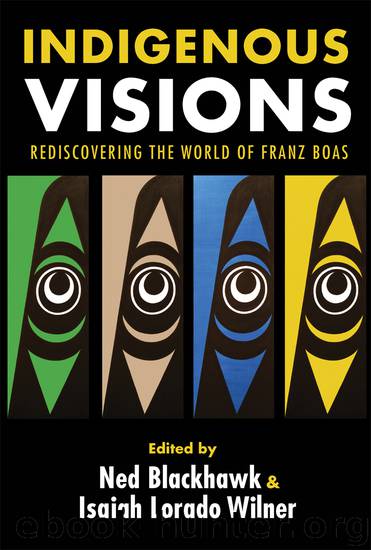Indigenous Visions by Ned Blackhawk Isaiah Lorado Wilner

Author:Ned Blackhawk,Isaiah Lorado Wilner
Language: eng
Format: epub
ISBN: 9780300196511
Publisher: Yale University Press
ARCHIVES OF COMPLEXION
Historical sources that offer information about human complexion must be approached not as transcriptions of any reality but as a way to illuminate the workings, meanings, and consequences of the ever-fickle endeavor of racial classification, an endeavor that draws its very strength from the powerful fiction of race. No historical record is ever a transparent window onto the past, yet scholars have often treated written sources (like census listings) and visual sources (like photographs) as definitive evidence of a person’s identification, incorporating those labels into the stories we tell about the lives of our historical actors. In writing histories of race—which are fundamentally histories of racial classification and racism—the more productive endeavor would be to spotlight and call out the unreliability of racial documentation in our historical records.2
Boas’s data sheets on Native American skin color must be considered in the context of a wide range of archival documents that inventory human complexion. Among these are advertisements for runaway slaves, designating the missing with racial categories like Negro and mulatto, augmented by adjectives (intended to aid in recapture) like brownish, tawny, red, yellowish, and white. Similarly, forms filled out by slave masters when the city of Washington, DC, abolished slavery in 1862 required a description of each freedperson; the terms there range from dark black to chestnut, copper-colored, bright yellow, pale yellow, very light, and nearly white. State enlistment rolls for African American soldiers in the Civil War likewise carry notations such as ebony, brown, medium, coffee, yellow, and light.3
Such invocations were not confined to people of African descent. Advertisements for runaway indentured servants, presumably of exclusive British or European descent, included terms like white, dark, swarthy, brown, fresh, and fair, while enlistment rolls for white Civil War soldiers encompassed such notations as sandy, florid, ruddy, muddy, sallow, and swarthy, and passport applications from the late nineteenth century labeled white people as fair, florid, brown, rosy, and sunburnt.4 Similar inventories can be found in legal testimony, medical records, and prison records as well as in personal recollections. Mamie Garvin Fields, born in South Carolina in 1888, described relatives and neighbors as being very dark, very fair, chocolate-brown, and olive; she remembered “‘white’ colored girls” and “light ‘black’ people” and families who were “a basketful of different skin colors.”5
Approaching the archives of complexion as historical documents entails, first, interrogating their purposes: Who wanted to know, and why? Who retained the power to name and fix the record of a person’s complexion? What inquiry invoked the description? Was a slavemaster hoping to capture his runaway property? Was a grandparent wishing to preserve a particular version of family history? Was an anthropologist hoping to discern natural distinctions among people of different continents? Equally important, we must interrogate the historical meanings and significance of particular terminology. A description of a woman’s skin as pale, for example, can signify delicacy and therefore a privileged class-status; a description of a man’s complexion as dark may be bound up with ideas of criminality. Narratives of skin
Download
This site does not store any files on its server. We only index and link to content provided by other sites. Please contact the content providers to delete copyright contents if any and email us, we'll remove relevant links or contents immediately.
| African-American Studies | Asian American Studies |
| Disabled | Ethnic Studies |
| Hispanic American Studies | LGBT |
| Minority Studies | Native American Studies |
Cecilia; Or, Memoirs of an Heiress — Volume 1 by Fanny Burney(32434)
Cecilia; Or, Memoirs of an Heiress — Volume 2 by Fanny Burney(31871)
Cecilia; Or, Memoirs of an Heiress — Volume 3 by Fanny Burney(31852)
The Great Music City by Andrea Baker(31348)
We're Going to Need More Wine by Gabrielle Union(18967)
All the Missing Girls by Megan Miranda(15565)
Pimp by Iceberg Slim(14393)
Bombshells: Glamour Girls of a Lifetime by Sullivan Steve(13972)
Talking to Strangers by Malcolm Gladwell(13222)
Norse Mythology by Gaiman Neil(13204)
Fifty Shades Freed by E L James(13157)
For the Love of Europe by Rick Steves(12977)
Mindhunter: Inside the FBI's Elite Serial Crime Unit by John E. Douglas & Mark Olshaker(9200)
Crazy Rich Asians by Kevin Kwan(9167)
The Lost Art of Listening by Michael P. Nichols(7406)
Enlightenment Now: The Case for Reason, Science, Humanism, and Progress by Steven Pinker(7228)
The Four Agreements by Don Miguel Ruiz(6630)
Bad Blood by John Carreyrou(6552)
Weapons of Math Destruction by Cathy O'Neil(6143)
